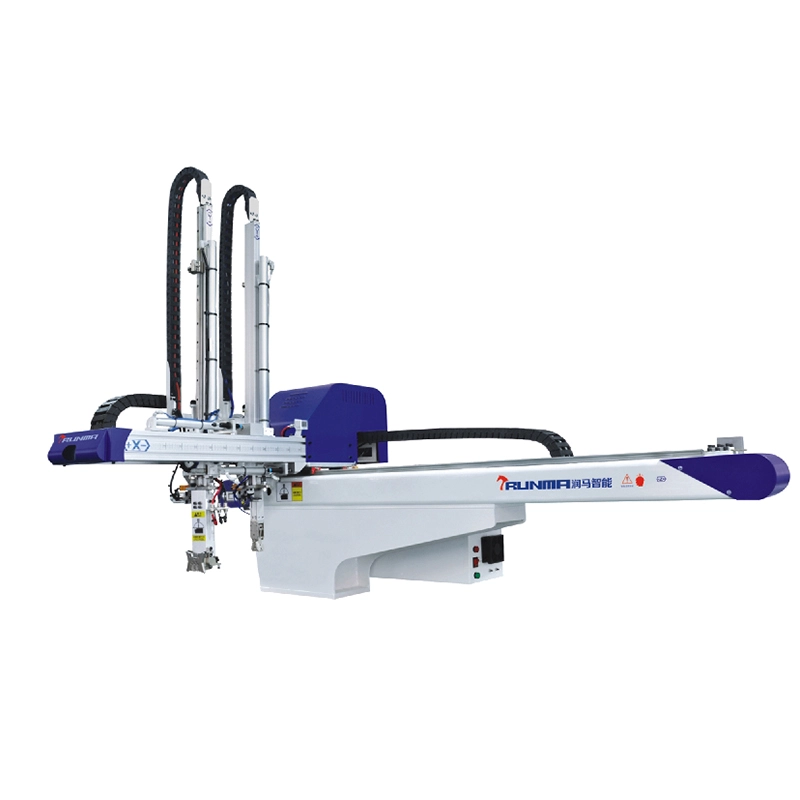Installation and maintenance of injection molding machine robot arm - part one
Matters needing attention in daily maintenance:
1. Hydraulic buffer: It should be replaced regularly.
2. The long-used cylinder end cover seals, rectifying gas pipes, and joints should be replaced in time.
3. Review and rectify wire connectors, plugs, sockets, etc. on schedule within 12 months.
4. Pneumatic components: The simple, multi-function robot arms all rely on the air source for propulsion, and the air source must not change and the shake is small and waterless.
Because gas and water are two different media: gas is invisible, water is tangible, and water retention in the air pipe, cylinder, and solenoid will produce scale, and the solenoid valve is stuck, resulting in gas carry-over, air seal worn out and leakage, internal and external leakage of cylinder. When the cylinder moves, it shows weakness, creeping, no movement or sudden movement, and the air pipe and the joint burst.
In summary, automated robot arm can effectively replace labor to improve the production efficiency of the enterprise, and the maintenance cost is low, but, in daily maintenance, careful maintenance is also required so as not to cause malfunctions of the automated robot arm and not to affect the production efficiency of the company's products.
For the operator, the daily maintenance work of the robot arm is very important. Next, we will introduce you to some notes:
1: Guide rails and bearings
The guide rails and bearings at all shafts should be kept clean and well lubricated. If the robot arm runs in a dusty environment, the rails need to be cleaned frequently. If you find any metal fragments or powder, it may indicate poor lubrication. In order to ensure proper lubrication, it is critical to have an appropriate linear guide system. Most robots have an automated lubrication system and components that need to be replaced regularly.
2: Robot arm cycle
One of the main points to keep the robot arm running well is simple observation and listening. Doing so can reveal a lot of information about the overall operation of the robot arm. The robot arm works through specific actions, so we should listen to any abnormal sounds, such as howling, clicks. These indicate that the bearing cannot rotate normally or some other component is stuck. The link part of the robot arm moves along the guide rail equipped with the power cable and the vacuum hose, and it will emit a normal ticking sound, but this sound is smooth and stable. Check any observable bearings to ensure that they rotate smoothly. Just checking and listening for signs of wear or adjustments can greatly help maintain the optimal operating state of the robot.
3: Drive system
If the robot arm is driven by an assembly frame-transmission gear, pay attention to whether any hesitation or shaking occurs during operation. All movements except smooth and steady movements can indicate that the drive system is damaged or some foreign objects are stored inside. When the robot arm pushes down, the method to quickly check the movement or backlash between the assembly beam and the transmission gear is to push and drag the movement arm and feel abnormal movement (the movement back and forth is different).
However, since ordinary manufacturer's tolerance precision is very high, this test method will be very inaccurate. If you suspect that there may be a problem in assembling the beam and the transmission gear, the better method is to use a magnetic gauge stand with a long range. After adjusting the backlash according to the manufacturer's instructions, check the entire stroke of the shaft to ensure that there is no too tight place between the assembly beam and the transmission gear. If the backlash cannot be adjusted, the mounting bracket and transmission gear may wear out and need to be replaced. If it is necessary to repair the assembly frame and the transmission gear, it is best to replace both components at the same time to ensure long-term performance.
As for the shaft driven by the conveyor belt, pay close attention to the debris and the damage of the conveyor belt. Check the pulley carefully and watch for signs of dust originating from the belt material. Make sure that the conveyor belt and drive pulleys and sheaves are fully aligned. Conveyor belts that deviate in direction wear out very quickly. As long as it is a belt-driven system, you can check the preload of the belt itself according to the manufacturer's instructions. These specifications will tell you: the appropriate amount of error in the specific position of the conveyor belt relative to the pulley.
